

Radiocarbon dating. Carbon-14. Carbon-14, 14C, or radiocarbon, is a radioactive isotope of carbon with a nucleus containing 6 protons and 8 neutrons. Its presence in organic materials is the basis of the radiocarbon dating method pioneered by Willard Libby and colleagues (1949) to date archaeological, geological and hydrogeological samples. Carbon-14 was discovered on 27 February 1940, by Martin Kamen and Sam Ruben at the University of California Radiation Laboratory in Berkeley. Its existence had been suggested by Franz Kurie in 1934.[2] There are three naturally occurring isotopes of carbon on Earth: 99% of the carbon is carbon-12, 1% is carbon-13, and carbon-14 occurs in trace amounts, i.e., making up about 1 part per trillion (0.0000000001%) of the carbon in the atmosphere. The different isotopes of carbon do not differ appreciably in their chemical properties. Radioactive decay and detection[edit] Carbon-14 goes through radioactive beta decay: Radiocarbon dating[edit] Origin[edit] 1n + 14N → 14C + 1p Occurrence[edit]
Radiocarbon 14 dating of the Shroud of Turin. The Shroud of Turin Carbon Dating in a School Textbook. SECRETS OF THE DEAD . Shroud of Christ? . Clues and Evidence. In 1988, an international team of scientific experts performed radiocarbon dating on snippets of the Shroud of Turin.
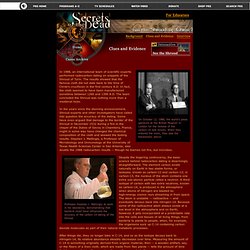
The results showed that the famous cloth did not date back to the time of Christ's crucifixion in the first century A.D. In fact, the cloth seemed to have been manufactured sometime between 1260 and 1390 A.D. The team concluded the Shroud was nothing more than a medieval hoax. In the years since the stunning announcement, Shroud experts and other investigators have called into question the accuracy of the dating. Some have even argued that damage to the border of the Shroud in December 1532 during a fire in the chapel of the Dukes of Savoy in Chambery, France, might in some way have changed the chemical composition of the cloth and skewed the testing results. Entropy and life. Origin[edit] In 1863, Rudolf Clausius published his noted memoir "On the Concentration of Rays of Heat and Light, and on the Limits of its Action" wherein he outlined a preliminary relationship, as based on his own work and that of William Thomson, between his newly developed concept of entropy and life.
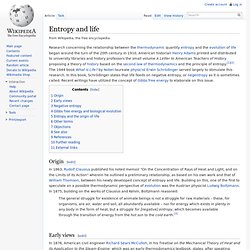
Building on this, one of the first to speculate on a possible thermodynamic perspective of evolution was the Austrian physicist Ludwig Boltzmann. What Is Life? What Is Life?

Is a 1944 non-fiction science book written for the lay reader by physicist Erwin Schrödinger. The book was based on a course of public lectures delivered by Schrödinger in February 1943, under the auspices of the Dublin Institute for Advanced Studies at Trinity College, Dublin. The lectures attracted an audience of about 400, who were warned "that the subject-matter was a difficult one and that the lectures could not be termed popular, even though the physicist’s most dreaded weapon, mathematical deduction, would hardly be utilized. "[1] Schrödinger's lecture focused on one important question: "how can the events in space and time which take place within the spatial boundary of a living organism be accounted for by physics and chemistry? " Earth and Environmental Sciences Book List, Science Teaching Department, Weizmann Institute. Erwin Schrödinger. Erwin Rudolf Josef Alexander Schrödinger (/ˈʃroʊdɪŋər/; German: [ˈɛʁviːn ˈʃʁøːdɪŋɐ]; 12 August 1887 – 4 January 1961), a Nobel Prize-winning Austrian physicist who developed a number of fundamental results in the field of quantum theory, which formed the basis of wave mechanics: he formulated the wave equation (stationary and time-dependent Schrödinger equation) and revealed the identity of his development of the formalism and matrix mechanics.
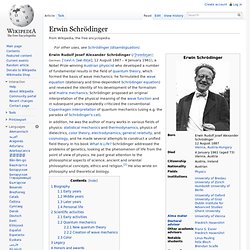
Schrödinger proposed an original interpretation of the physical meaning of the wave function and in subsequent years repeatedly criticized the conventional Copenhagen interpretation of quantum mechanics (using e.g. the paradox of Schrödinger's cat). In addition, he was the author of many works in various fields of physics: statistical mechanics and thermodynamics, physics of dielectrics, color theory, electrodynamics, general relativity, and cosmology, and he made several attempts to construct a unified field theory. In his book What Is Life? What is life?
שרדינגר עושה חיים Schrodinger. Avshalom elitzur information theory - חיפוש ב-Google. Information Theory Does Not Apply To The Evolution Of The Biosphere : 13.7: Cosmos And Culture. We live in the Information Age.
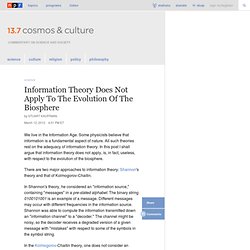
Some physicists believe that information is a fundamental aspect of nature. All such theories rest on the adequacy of information theory. In this post I shall argue that information theory does not apply, is, in fact, useless, with respect to the evolution of the biosphere. There are two major approaches to information theory: Shannon's theory and that of Kolmogorov-Chaitin. In Shannon's theory, he considered an "information source," containing "messages" in a pre-stated alphabet.
6613/1/Dualism0409.pdf. Elitzur–Vaidman bomb tester. Bomb-testing problem diagram.
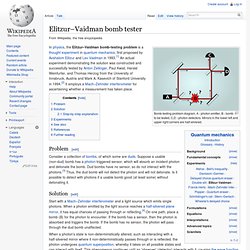
A - photon emitter, B - bomb to be tested, C,D - photon detectors. Mirrors in the lower left and upper right corners are half-silvered. In physics, the Elitzur–Vaidman bomb-testing problem is a thought experiment in quantum mechanics, first proposed by Avshalom Elitzur and Lev Vaidman in 1993.[1] An actual experiment demonstrating the solution was constructed and successfully tested by Anton Zeilinger, Paul Kwiat, Harald Weinfurter, and Thomas Herzog from the University of Innsbruck, Austria and Mark A. Kasevich of Stanford University in 1994.[2] It employs a Mach–Zehnder interferometer for ascertaining whether a measurement has taken place.
Problem[edit] Negentropy. In a note to What is Life?
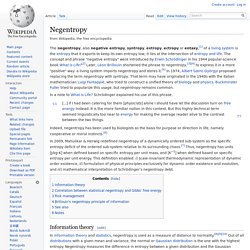
Schrödinger explained his use of this phrase. Indeed, negentropy has been used by biologists as the basis for purpose or direction in life, namely cooperative or moral instincts.[6] In 2009, Mahulikar & Herwig redefined negentropy of a dynamically ordered sub-system as the specific entropy deficit of the ordered sub-system relative to its surrounding chaos.[7] Thus, negentropy has units [J/kg-K] when defined based on specific entropy per unit mass, and [K−1] when defined based on specific entropy per unit energy. This definition enabled: i) scale-invariant thermodynamic representation of dynamic order existence, ii) formulation of physical principles exclusively for dynamic order existence and evolution, and iii) mathematical interpretation of Schrödinger's negentropy debt.
Information theory[edit] החוק השני של התרמודינמיקה בביולוגיה – אקו-ויקי. מתוך אקו-ויקי, מקום מפגש בנושאי אקולוגיה, חברה וכלכלה.
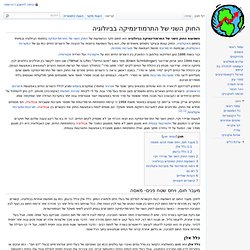
השפעות החוק השני של התרמודינמיקה בביולוגיה הוא תחום חקר ההשפעות של החוק השני של התרמודינמיקה בתחומי הביולוגיה ובמיוחד בתחום האקולוגיה. החוק עצמו ובעיקר ניסוחים מאוחרים שלו, הוא בעל השפעות נרחבות על ההבנה של היצורים החיים כמו גם של המערכת האקולוגית, שבמינוח תרמודינמי מהוות דוגמאות של מערכות מפזרות. כבר בשנת 1886 טען הפיזיקאי בולמצן כי המאבק בין היצורים החיים הוא על אקסרגיה ועל הורדת אנטרופיה. בשנת 1944 כתב ארווין שרדינגר (Erwin Schrödinger) ספר בשם "מהם החיים?
" (What is Life?) הפתרון לפרדוקס לכאורה זה הוא שהחיים נמצאים בתוך שטף של אנרגיה (וחומר) שמקורם בשמש ומגיע לכלל היצורים החיים באמצעות היצרנים הראשוניים. החוקרים אריק שניידר וג'יימס קיי טוענים במאמר משנת 1994 כי קיימת התפתחות תרמודינמית של מספר מערכות שעוברות אבולוציה, הם מנסחים מחדש את החוק, ומרחיבים אותו למערכות רחוקות משיווי משקל. לטענת שניידר וקיי, החוק השני של התרמודינמיקה הוא תנאי הכרחי אך לא מספיק לקיום החיים. מעבר חום, ויחס שטח פנים- מאסה כלל אלן כלל ברגמן חתך של תא ברנרד. Isotopic fractionation (chemistry.